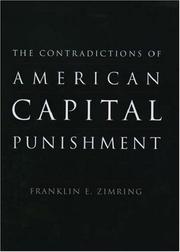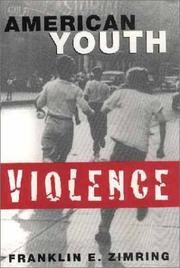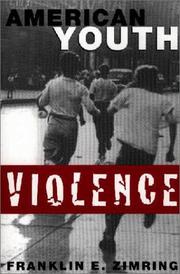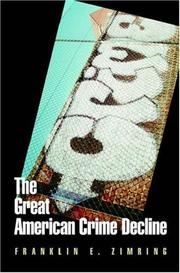| Listing 1 - 10 of 58 | << page >> |
Sort by
|

ISBN: 0195152360 Year: 2003 Volume: *2 Publisher: Oxford Oxford University Press
Abstract | Keywords | Export | Availability | Bookmark
 Loading...
Loading...Choose an application
- Reference Manager
- EndNote
- RefWorks (Direct export to RefWorks)
Book
ISBN: 9780199844425 0199844429 Year: 2012 Publisher: New York (N.Y.): Oxford university press,
Abstract | Keywords | Export | Availability | Bookmark
 Loading...
Loading...Choose an application
- Reference Manager
- EndNote
- RefWorks (Direct export to RefWorks)
Crime prevention --- Crime --- Police --- Prevention of crime --- Public safety --- Prevention --- Government policy --- Geschichte 1991-2011. --- Cops --- Gendarmes --- Law enforcement officers --- Officers, Law enforcement --- Officers, Police --- Police forces --- Police officers --- Police service --- Policemen --- Policing --- Criminal justice, Administration of --- Criminal justice personnel --- Peace officers --- Security systems --- City crime --- Crime and criminals --- Crimes --- Delinquency --- Felonies --- Misdemeanors --- Urban crime --- Social problems --- Criminal law --- Criminals --- Criminology --- Transgression (Ethics) --- Legal status, laws, etc. --- Social aspects --- Crime prevention - New York (State) - New York --- Crime - New York (State) - New York --- Police - New York (State) - New York
Book
ISBN: 9780674986800 0674986806 Year: 2018 Publisher: Cambridge: Harvard university press,
Abstract | Keywords | Export | Availability | Bookmark
 Loading...
Loading...Choose an application
- Reference Manager
- EndNote
- RefWorks (Direct export to RefWorks)
Deaths of civilians at the hands of on-duty police are in the national spotlight as never before. How many killings by police occur annually? What circumstances provoke police to shoot to kill? Who dies? The lack of answers to these basic questions points to a crisis in American government that urgently requires the attention of policy experts. When Police Kill is a groundbreaking analysis of the use of lethal force by police in the United States and how its death toll can be reduced.Franklin Zimring compiles data from federal records, crowdsourced research, and investigative journalism to provide a comprehensive, fact-based picture of how, when, where, and why police resort to deadly force. Of the 1,100 killings by police in the United States in 2015, he shows, 85 percent were fatal shootings and 95 percent of victims were male. The death rates for African Americans and Native Americans are twice their share of the population.Civilian deaths from shootings and other police actions are vastly higher in the United States than in other developed nations, but American police also confront an unusually high risk of fatal assault. Zimring offers policy prescriptions for how federal, state, and local governments can reduce killings by police without risking the lives of officers. Criminal prosecution of police officers involved in killings is rare and only necessary in extreme cases. But clear administrative rules could save hundreds of lives without endangering police officers.“Roughly 1,000 Americans die each year at the hands of the police…The civilian body count does not seem to be declining, even though violent crime generally and the on-duty deaths of police officers are down sharply…Zimring’s most explosive assertion―which leaps out…―is that police leaders don’t care…To paraphrase the French philosopher Joseph de Maistre, every country gets the police it deserves.”―Bill Keller, New York Times“If you think for one second that the issue of cop killings doesn’t go to the heart of the debate about gun violence, think again. Because what Zimring shows is that not only are most fatalities which occur at the hands of police the result of cops using guns, but the number of such deaths each year is undercounted by more than half!…[A] valuable and important book…It needs to be read.”―Mike Weisser, Huffington Post

ISBN: 1280470704 9786610470709 1423760042 0195352904 1602562938 9781602562936 9780195121452 0195121457 9781423760047 6610470707 0195121457 0197718337 Year: 2023 Publisher: New York ; Oxford University Press,
Abstract | Keywords | Export | Availability | Bookmark
 Loading...
Loading...Choose an application
- Reference Manager
- EndNote
- RefWorks (Direct export to RefWorks)
This is an examination of adolescent violence in the United States as both a social phenomenon and a policy problem. Franklin Zimring, a scholar of law and crime, scrutinizes criminal statistics and demographic trends in order to authoritatively address public worries.
Juvenile delinquency --- Violent crimes --- Juvenile justice, Administration of --- Crimes, Violent --- Crimes of violence --- Crime --- Violence --- Delinquency, Juvenile --- Juvenile crime --- Conduct disorders in children --- Juvenile corrections --- Reformatories --- Government policy

ISBN: 0195184866 1280428406 0198034792 1602565430 9780198034797 0195178203 9780195178203 9780195184860 9780195152364 0195152360 9780195166378 019516637X 9781602565432 9781280428401 9786610428403 6610428409 0195152360 0190292377 0197733115 Year: 2023 Publisher: Oxford : Oxford University Press,
Abstract | Keywords | Export | Availability | Bookmark
 Loading...
Loading...Choose an application
- Reference Manager
- EndNote
- RefWorks (Direct export to RefWorks)
In the last 25 years almost every Western country has moved to abolish the death penalty. The United States is the exception. This novel thesis argues that a tradition of popular justice conflicts with the legal tradition of due process.
Capital punishment --- Punishment --- 343.25 <73> --- -Abolition of capital punishment --- Death penalty --- Death sentence --- Criminal law --- Executions and executioners --- 343.25 <73> Lijfstraffen. Doodstraf--Verenigde Staten van Amerika. VSA. USA --- Lijfstraffen. Doodstraf--Verenigde Staten van Amerika. VSA. USA --- -343.25 <73> Lijfstraffen. Doodstraf--Verenigde Staten van Amerika. VSA. USA --- Abolition of capital punishment --- -Capital punishment
Book
ISBN: 0195378989 1429459212 0199702535 1280845414 019534619X 9780199702534 9780195378986 019994413X 0190207612 Year: 2006 Publisher: Oxford University Press
Abstract | Keywords | Export | Availability | Bookmark
 Loading...
Loading...Choose an application
- Reference Manager
- EndNote
- RefWorks (Direct export to RefWorks)
Many theories - from the routine to the bizarre - have been offered up to explain the crime decline of the 1990s. Was it record levels of imprisonment? An abatement of the crack cocaine epidemic? More police using better tactics? Or even the effects of legalized abortion? And what can we expect from crime rates in the future? Franklin E. Zimring here takes on the experts, and counters with the first in-depth portrait of the decline and its true significance. Themajor lesson from the 1990s is that relatively superficial changes in the character of urban life can be associated with up to 75% drops in the crime rate. Crime can drop even if there is no major change in the population, the economy or the schools.Offering the most reliable data available, Zimring documents the decline as the longest and largest since World War II. It ranged across both violent and non-violent offenses, all regions, and every demographic. All Americans, whether they live in cities or suburbs, whether rich or poor, are safer today. Casting a critical and unerring eye on current explanations, this book demonstrates that both long-standing theories of crime prevention and recently generated theories fall far short ofexplaining the 1990s drop. A careful study of Canadian crime trends reveals that imprisonment and economic factors may not have played the role in the U.S. crime drop that many have suggested.There was no magic bullet but instead a combination of factors working in concert rather than a single cause that produced the decline. Further - and happily for future progress, it is clear that declines in the crime rate do not require fundamental social or structural changes. Smaller shifts in policy can make large differences. The significant reductions in crime rates, especially in New York, where crime dropped twice the national average, suggests that there is room for other cities to repeat this astounding success. In this definitive look at the great American crime decline, Franklin E. Zimring finds no pat answers but evidence that even lower crime rates might be in store.
Book
ISBN: 067497803X 0674978056 Year: 2017 Publisher: Cambridge, MA : Harvard University Press,
Abstract | Keywords | Export | Availability | Bookmark
 Loading...
Loading...Choose an application
- Reference Manager
- EndNote
- RefWorks (Direct export to RefWorks)
When Police Kill is the first comprehensive analysis of police use of lethal force in the United States. The first seven chapters of this volume provide a summary and analysis of the known facts about killings by police. Who dies from police gunfire? What circumstances provoke police to shoot? Why is the death rate from shootings by police so high? Why are civilian deaths from police attacks so much higher in the United States than in other developed nations? Why are police also so much more at risk of death by assault than police in other nations? The final five chapters of the book provide an account of how federal, state and local governments can reduce killings by police without risking the lives of police officers. There are many strategies that federal and state government can use to motivate changes by police chiefs and sheriffs, but local law enforcement agencies are the main arena for reducing the carnage from police violence in the United States.--
Police shootings --- Police administration --- Police --- Police-community relations --- Cops --- Gendarmes --- Law enforcement officers --- Officers, Law enforcement --- Officers, Police --- Police forces --- Police officers --- Police service --- Policemen --- Criminal justice, Administration of --- Criminal justice personnel --- Peace officers --- Public safety --- Security systems --- Deadly force used by police --- Police use of deadly force --- Shootings by police --- Use of deadly force by police --- Police patrol --- Suicide by cop --- Violence against --- Legal status, laws, etc.

ISBN: 019514063X Year: 2000 Publisher: Oxford Oxford University Press
Abstract | Keywords | Export | Availability | Bookmark
 Loading...
Loading...Choose an application
- Reference Manager
- EndNote
- RefWorks (Direct export to RefWorks)

ISBN: 9780195181159 Year: 2007 Publisher: Oxford Oxford university press.
Abstract | Keywords | Export | Availability | Bookmark
 Loading...
Loading...Choose an application
- Reference Manager
- EndNote
- RefWorks (Direct export to RefWorks)
Crime --- History --- United States --- Economic conditions --- Social conditions
Book
ISBN: 9780674978058 0674978056 9780674972186 067497218X 067497803X 0674986806 Year: 2017 Publisher: Harvard University Press
Abstract | Keywords | Export | Availability | Bookmark
 Loading...
Loading...Choose an application
- Reference Manager
- EndNote
- RefWorks (Direct export to RefWorks)
| Listing 1 - 10 of 58 | << page >> |
Sort by
|

 Search
Search Feedback
Feedback About UniCat
About UniCat  Help
Help News
News